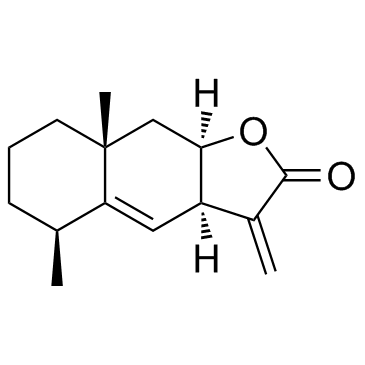Alantolactone

Alantolactone structure
|
Common Name | Alantolactone | ||
|---|---|---|---|---|
| CAS Number | 546-43-0 | Molecular Weight | 232.318 | |
| Density | 1.1±0.1 g/cm3 | Boiling Point | 275.0±0.0 °C at 760 mmHg | |
| Molecular Formula | C15H20O2 | Melting Point | 78-79ºC | |
| MSDS | Chinese USA | Flash Point | 111.5±18.2 °C | |
| Symbol |

GHS07 |
Signal Word | Warning | |
Use of AlantolactoneAlantolactone is a selective STAT3 inhibitor, with potent anticancer activity. |
| Name | alantolactone |
|---|---|
| Synonym | More Synonyms |
| Description | Alantolactone is a selective STAT3 inhibitor, with potent anticancer activity. |
|---|---|
| Related Catalog | |
| Target |
STAT3 |
| In Vitro | Alantolactone induces apoptosis in HepG2 cells in a dose-dependent manner. This Alantolactone-induced apoptosis is found to be associated with GSH depletion, inhibition of STAT3 activation, ROS generation, mitochondrial transmembrane potential dissipation, and increased Bax/Bcl-2 ratio and caspase-3 activation[1]. Alantolactone decreases STAT3 translocation to the nucleus, its DNA-binding, and STAT3 target gene expression. Alantolactone significantly inhibits STAT3 activation with a marginal effect on MAPKs and on NF-κB transcription; however, this effect is not mediated by inhibiting STAT3 upstream kinases[2]. |
| In Vivo | It is found that the average tumor volume in the Alantolactone-treated mice is approximately 2.17-fold lower compared with that in the control mice. However the administration of Alantolactone does not affect the overall bodyweight during the experimental period, suggesting no apparent toxicity. Additionally, the average tumor weight is significantly lower in the Alantolactone-treated mice compared with the control mice. What’s more, the administration of Alantolactone results in a significant decrease in p-STAT3 and cyclin D1 expression in the tumor tissues[2]. |
| Cell Assay | Cells are cultured for 24 h before drug treatment in 96 well plates. Cells were treated with Alantolactone (0, 10, 20, 30, 40, 50, and 60 μM) for 12 h and cell viability is measured by MTT assay[1]. |
| Animal Admin | Mice[2] Female athymic BALB/c nude mice at the age of 6 weeks are used. MDA-MB-231 cells (5×106 cells/200 μL) are subcutaneously injected into the right flanks of the mice. Ten days after the injection of cells, mice are randomly divided into treatment and control groups (n=5). The animals are administered Alantolactone (2.5 mg/kg of body weight, suspended in DMSO 0.1% v/v, 100 μL i.p. injection) every 2 days, whereas control animals are treated with an equal volume of saline[2]. |
| References |
| Density | 1.1±0.1 g/cm3 |
|---|---|
| Boiling Point | 275.0±0.0 °C at 760 mmHg |
| Melting Point | 78-79ºC |
| Molecular Formula | C15H20O2 |
| Molecular Weight | 232.318 |
| Flash Point | 111.5±18.2 °C |
| Exact Mass | 232.146332 |
| PSA | 26.30000 |
| LogP | 3.69 |
| Vapour Pressure | 0.0±0.5 mmHg at 25°C |
| Index of Refraction | 1.534 |
| Storage condition | ?20°C |
| HS Code | 2932209090 |
|---|---|
| Summary | 2932209090. other lactones. VAT:17.0%. Tax rebate rate:13.0%. . MFN tariff:6.5%. General tariff:20.0% |
|
Pharmacokinetics, tissue distribution and excretion of isoalantolactone and alantolactone in rats after oral administration of Radix Inulae extract.
Molecules 20 , 7719-36, (2015) Radix Inulae is endemic to China and has been used in traditional medicine to treat upper body pain, emesis and diarrhoea, and to eliminate parasites. Here, an UPLC-MS/MS method was developed and appl... |
|
|
A fluorescence high throughput screening method for the detection of reactive electrophiles as potential skin sensitizers.
Toxicol. Appl. Pharmacol. 289 , 177-84, (2015) Skin sensitization is an important toxicological end-point in the risk assessment of chemical allergens. Because of the complexity of the biological mechanisms associated with skin sensitization, inte... |
|
|
Anti-allergic effects of sesquiterpene lactones from the root of Aucklandia lappa Decne.
Mol. Med. Report. 12 , 7789-95, (2015) Aucklandia lappa Decne, a well-known traditional herbal medicine, is used for the treatment of asthma, rheumatism, coughs, tuberculosis and numerous other diseases. The present study evaluated the inh... |
| 8b-Hydroxy-4aH-eudesm-5-en-12-oic Acid g-Lactone |
| Naphtho[2,3-b]furan-2(3H)-one, 3a,5,6,7,8,8a,9,9a-octahydro-5,8a-dimethyl-3-methylene-, (3aR,5S,8aR,9aR)- |
| (3aR,5S,8aR,9aR)-5,8a-dimethyl-3-methylidene-3a,5,6,7,8,8a,9,9a-octahydronaphtho[2,3-b]furan-2(3H)-one |
| [3aR-(3aa,5b,8ab,9aa)]-3a,5,6,7,8,8a,9,9a-Octahydro-5,8a-dimethyl-3-methylenenaphtho[2,3-b]furan-2(3H)-one |
| Inula camphor |
| ALLANTOLACTONE |
| MFCD00046915 |
| Helenin |
| HELENINE |
| ALANTOLACTONE |
| Elecampane camphor |
| ALANTOLACETONE |
| Eupatal |
| EINECS 208-899-3 |
| (3aR,5S,8aR,9aR)-5,8a-Dimethyl-3-methylene-3a,5,6,7,8,8a,9,9a-octahydronaphtho[2,3-b]furan-2(3H)-one |
| Alant camphor |

